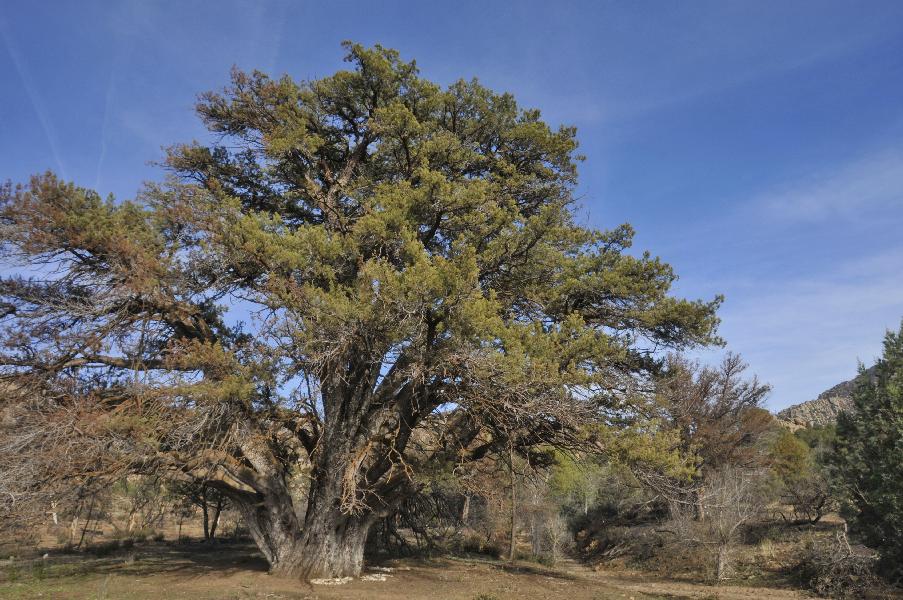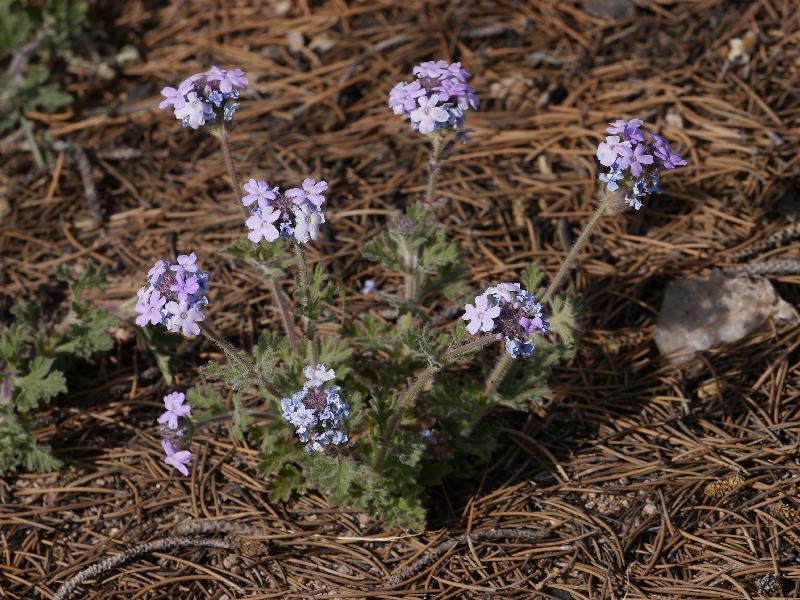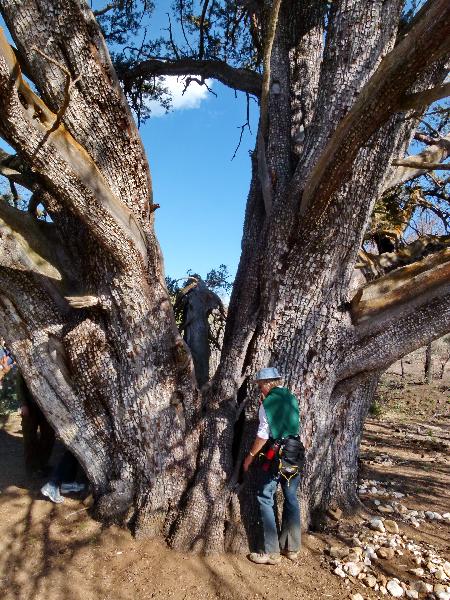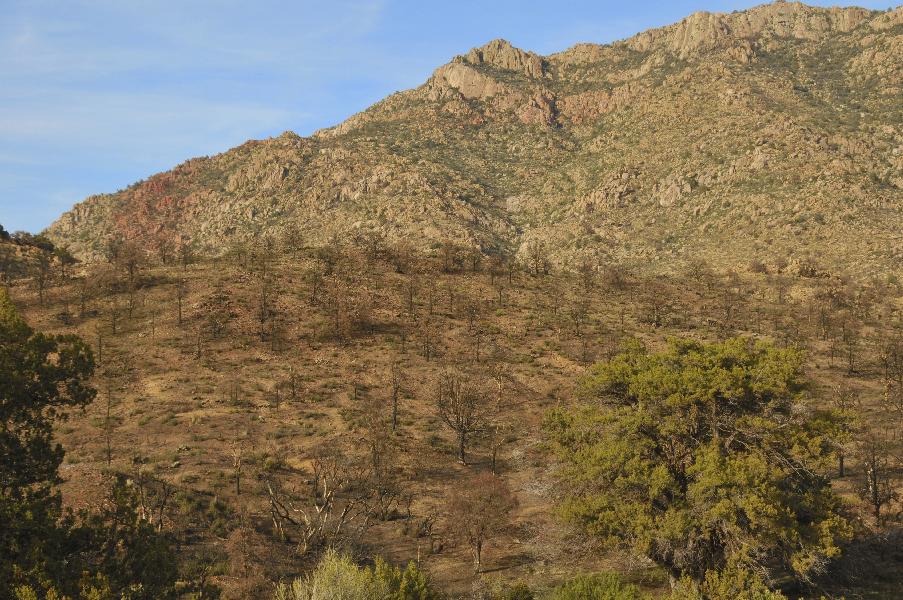June 30, 2014 marks the first-year anniversary of the tragic Yarnell Hill fire that took the lives of 19 Granite Mountain Hotshots. A day of infamy in US fire history, it has provoked abundant reflection and some action.
Twelve days before the fatal, fateful fire, another blaze, the Doce Fire, started in dense chaparral and shot northward, propelled by powerful winds. It jumped the highway and sped up over both Little Granite Mountain and Granite Mountain itself, descending with unexpected ferocity down the north slope right up to the edge of homes in Williamson Valley. It was a terrifying reminder of the power of nature that can overwhelm the puny efforts of humans, even with our advanced technology. It was humbling.
There were bright spots in that human-nature conflict. The 20-man Granite Mountain Hotshots team was aware of the ancient alligator juniper that grew in view of both mountains for centuries. Revered and respected, that tree stood in the line of fire. But for the intervention of the hotshots, it might today be nothing more than a lifeless, charred trunk, victim of one fire too many. The crew saved it by creating firebreaks and by using their personal water containers to put out spot fires in its branches. This was an act of thoughtful heroism; these men put themselves on the fire line simply to save a tree.
But it was, and still is, more than a tree—it is a symbol of resistance, of fortitude, of ancient wisdom. In other words, it stands for values we admire and care about. It was the tree, not a tree. And it survived.
April 13, 2014. Thirty people assemble several miles away to undertake a pilgrimage to that sacred tree. I have been asked to lead the hike that will culminate in a ceremony of remembrance. When I scouted a week before, I noted the mosaic of burned and unburned, patterns almost whimsical but indicative of the chaotic winds that drove the flames. When I reached the grand juniper, I was nearly overwhelmed with emotion. I spent an hour in the ashes north of the tree before I finally stepped forward to touch it.
Now I lead the group up the closed fire road through chaparral and pinyon-juniper stands untouched by the Doce blaze. We stop periodically to discuss the ecology of these ecosystems, especially their dependence on fire. I also mention the state of the pine forests around Prescott—artificial ecosystems created by logging and fire suppression (mainly by grazing initially) –and how vulnerable the city remains. If a fire were to start around Prescott during conditions such as drove the Yarnell fire, we could have a fire on steroids that might take out hundreds, if not thousands, of homes. Prescott remains a potential powder keg. We are not out of the woods yet on that one!
When we reach the two trailheads at the end of the fire road, the rules change. We walk the final mile to the ancient juniper in complete silence. There is an air of anticipation. Skeletons of charred trees contrast with vivid green sprouts at the base of former oaks, while pastel-hued verbenas show their pretty bouquets where they have been released from the stifling shade of former brush. As always in nature, there are winners and losers.
We reach the revered juniper, pausing in the burned area to the north. Here Doug Hulmes, Prescott College professor and champion of sacred trees, explains how he and a group of students from Norway chanced to encounter the sole surviving member of the Granite Mountain Hotshots at this very tree not long ago. Then Bethany Hannah, herself a hotshot firefighter, speaks of the obvious care that the GM Hotshots took when they built their firebreaks. The evidence speaks of respect and caring.
The ceremony begins, led by Connie Barlow (champion of assisted migration as a strategy to save tree species that could be stranded by the effects of global warming) and Michael Dowd (evolutionary theologian and author of Thank God for Evolution). We each draw two cards, and then, one by one, we walk toward the tree and solemnly read one of the names on our cards. It is either one of the fallen hotshots or a species that has gone extinct in the United States at the hand of humans. Michael taps a bell after each name. We listen, grieve, and remember. It is one of the most powerful ceremonies I have ever experienced.
Then we approach the tree, massive at its base and spreading its huge branches out laterally farther than it is tall. We touch its rough bark, witness its many scars, even embrace the trunk lovingly. Joan Dukes reads a remembrance; she first visited this tree over forty years ago. Forty years is significant in human scale, but a moment in the lifespan of this tree.
This ancient tree has beaten the odds. Most of the berries that junipers produce are eaten by mammals or birds or fall where there is no hope of germination or long-term survival. Fires inevitably occur, and wood is inherently combustible. This singular juniper that so impressed and inspired us is a one-in-a-million survivor. How many of the younger trees and saplings nearby are its offspring? Eventually it will die, and its genetic legacy will live on in its offspring. As long as the climate does not shift too far, Connie would remind us.
The cultural legacy of this impressive alligator juniper depends on us. We will need to pass on its story, generation after generation, or that will disappear as surely as wood rots into the ground. So too the Granite Mountain Hotshots. Their story also depends on us. May we never forget.





Walt, will you be taking this hike on June 30 of this year (2015)? A group of us would very much like to go with you if you do –
Sally Bethea
I just got back from Tanzania and did not get focused to thinking about a return trip to the juniper. I did let Beth Hannah use my photos for her remembrance.
Cheers,
Walt
Hi thanku so much for sharing ur thoughtful touching memories with us. Can u tell me how to get to this tree coming from chino valley? Id love to visit it thanku- desirae
Dezipezi2929@live.com
If u can please email me back
I am emailing you directions. If anyone else needs directions, please contact me.
Will you please send me how to get to the tree I live in Prescott valley and cannot find where or how to get to it.
Erikmoore14@gmail.com
I WOULD APPRECIATE DIRECTIONS FROM WICKENBURG TO THE JUNIPER TREE. THANK YOU. JUDY PARKS
I am http://www.geolobo.com/. Here are some essays specific to the fires:
Burning Desires & Incendiary Thoughts http://www.geolobo.com/?p=401
Granite Mountain Ablaze http://www.geolobo.com/?p=414
Yarnell Fire http://www.geolobo.com/?p=453
Heroes: Reflections on the Granite Mt. Hotshots http://www.geolobo.com/?p=462
Landscape Lunacy: Yarnell on Fire http://www.geolobo.com/?p=464
Yarnell Revisited http://www.geolobo.com/?p=483
Hotshots & the Juniper http://www.geolobo.com/?cat=143
Please feel free to share or to put a share to the links on Face Book.
Cheers,
Walt
I would also love directions to this tree from Phoenix. thank you!
I am http://www.geolobo.com/. Here are some essays specific to the fires:
Burning Desires & Incendiary Thoughts http://www.geolobo.com/?p=401
Granite Mountain Ablaze http://www.geolobo.com/?p=414
Yarnell Fire http://www.geolobo.com/?p=453
Heroes: Reflections on the Granite Mt. Hotshots http://www.geolobo.com/?p=462
Landscape Lunacy: Yarnell on Fire http://www.geolobo.com/?p=464
Yarnell Revisited http://www.geolobo.com/?p=483
Hotshots & the Juniper http://www.geolobo.com/?cat=143
Please feel free to share or to put a share to the links on Face Book.
Cheers,
Walt
My wife Tammy and I went to Yarnell the day after they opened the road, taking shovels, rakes, lawn chairs, and whatever else we could fit in the car, we figured the people of Yarnell would be needing those items, it was devastating to see the damage but yet so touching to see the personally made signs and monuments of the residence for the 19 Hotshots. When it came time for the funeral We completely respected the families of the 19 letting them remember their own in private,… We have been to Yarnell several times now and just saw the movie “Only The Brave” and is the first we heard about the Juniper. I am with a group of 10 Retired Military and would like to organize a trip to the Juniper, and Wondering if your doing or would be willing to do another memorial Hike to it in the future, allowing us to join you??
Hi, Greg and Tammy. Good for you for your service to the Yarnell community. I would be happy to guide your group out there and provide a fair amount of interpretation (that’s what I do!) for a modest honorarium, say $100. If interested, please contact me directly at geolobo@cableone.net. Thanks. Walt
I am http://www.geolobo.com/. Here are some essays specific to the fires:
Burning Desires & Incendiary Thoughts http://www.geolobo.com/?p=401
Granite Mountain Ablaze http://www.geolobo.com/?p=414
Yarnell Fire http://www.geolobo.com/?p=453
Heroes: Reflections on the Granite Mt. Hotshots http://www.geolobo.com/?p=462
Landscape Lunacy: Yarnell on Fire http://www.geolobo.com/?p=464
Yarnell Revisited http://www.geolobo.com/?p=483
Hotshots & the Juniper http://www.geolobo.com/?cat=143
Please feel free to share or to put a share to the links on Face Book.
Cheers,
Walt
Walt,
I recently watch Only the Brave and was heart broken and moved. Your article here are absolutely touching. I would like to pay tribute to the fallen Hotshots by visiting the tree. Can you please provide direction coming from Phoenix?